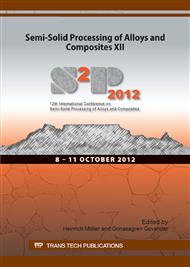p.482
p.488
p.494
p.500
p.506
p.515
p.521
p.527
p.533
Casting Wear-Resistant Functionally Gradient Ferrous Alloys via Partial Solidification Processing
Abstract:
The CDC (Cast-Decant-Cast) Process is novel semi-solid processing method for joining two alloys, allowing the production of components from two or more alloys. The process produces a functionally gradient material (FGM) which, instead of having a sharp interface between the two alloys, features a transition region exhibiting a smooth gradient in concentration, microstructure and properties. Functionally gradient materials provide engineers with the flexibility to design components with different material properties at different locations. The details of the CDC Process are described. This paper, for the first time, provides information regarding the fabrication of functionally gradient castings from steels, cast irons and cobalt alloys. The first example involves the production of functionally gradient castings from a Ni-Hard cast iron + mild steel. The second example describes the production of functionally gradient castings from Stellite + mild steel. Processing parameters are documented and microstructures of the castings described.
Info:
Periodical:
Pages:
506-511
Citation:
Online since:
October 2012
Authors:
Keywords:
Price:
Сopyright:
© 2013 Trans Tech Publications Ltd. All Rights Reserved
Share:
Citation:


